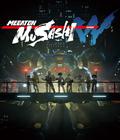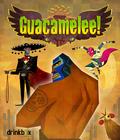For such a lauded franchise, Metroid has few imitators. There are plenty of games with Metroid-like elements, but not many that are wholehearted copies. The closest are the post-Symphony of the Night games in the Castlevania franchise, which spawned the term "Metroidvania." Perhaps that's why Guacamelee is so refreshing. Sometimes a straightforward copy can seem dull, but when nobody else can deliver, it becomes more interesting. Guacamelee does more than just go through the motions.
Guacamelee's plot is simple in all the right ways. Players take on the role of Juan Aguacate, a rustic farmer from a small town. Everything in his life changes when his childhood friend, the daughter of the loyal mayor, returns from a trip. Just as the two are about to reunite, an evil undead monster named Carlos Calaca appears, kidnaps the El Presidente's daughter, and kills Juan. Fate intervenes, and Juan is resurrected by a magical luchador mask that grants him amazing powers. He sets out to rescue his lady friend and defeat the evil Carlos before he can destroy the world of the living.
One of the few things that holds Guacamelee back is its stale humor. The majority of its humor seems to consist of references to Internet or video game jokes. The billboards and random NPCs are plastered with Reddit memes, references to other games, and other out-of-place cameos that seem to exist mostly to say, "Hey, look, this thing exists!" It's a shame because the animations are charming, and the game does a good job of making the characters dynamic and fun to watch. Juan's broad-chinned heroic posture never fails to be amusing. In some ways, it feels like the developers didn't feel like the world was good enough on its own. Hopefully, any sequel will be confident enough to rely on its own humor instead.
Guacamelee is a 2D action/platformer that is a shameless homage to Metroid, with a dash of the Igarashi-helmed Castlevania. They're not trying to hide this, either. One of the aforementioned in-jokes is that Juan earns every power-up from breaking "Chozoo statues," a near-copy of the Chozo statues from the Metroid games. The good news is that Guacamelee isn't just aping the basic visuals. From the moment you pick up the game, it's clear that the developers have a firm grasp of what people want from a "Metroidvania" game. It has its missteps, but none detract from the overall game.
The combat system in Guacamelee is simple but addictive. At the start, you're playing a simple brawler with a by-the-numbers combo system. You have a single attack button, which you can use for a three-hit combo or an air combo. If you do enough damage, the enemy is stunned, allowing you to grab and toss him at other enemies. It sounds one-dimensional, but you get new moves and abilities at an incredibly quick rate. For example, your throw can be upgraded with a suplex, a pile driver, or a powerful upgraded kick. The suplex does splash damage, the pile driver does a lot of single-target damage, and the kick sends enemies flying at great speeds. You've also got a powerful dodge move that lets you avoid attacks, and with proper timing, you can even dodge them.
As the game progresses, you unlock special abilities, which are called Power Moves. Each Power Move uses a block of stamina, with stamina taking a few seconds to regenerate. A Power Move can extend a combo and do additional damage. You can perform a dashing punch, a ground-pound, a head-butt and an uppercut. Stringing together these moves allows you to perform lengthy and damaging combos. Certain enemies will build up defenses against the combos. The defenses come in the form of colored auras, with each aura corresponding to a matching attack. When an enemy has an aura, he's immune to all damage until you hit him with the correctly colored attack. There are also white auras, which are immune to all Power Moves but can be broken by repeated attacks.
Unlike the recently released DmC, the color coding of enemies is only a minor obstacle. You can still knock around a color-coded enemy; he just won't take damage. This makes it easier to get an enemy into the air so you can combo him into a Power Move. More important is the fact that hitting an enemy with a correctly colored power move also temporarily disables his shield. This prevents the annoying problem in DmC, where your options were limited by the enemy's coloring. You have to make sure to work in a head-butt or uppercut, but you're not limited to those moves. The combo system is fluid and fun, so if you want to invest the time, you can perform lengthy combos. If you don't, then you can master a few bread-and-butter combos and do fine. It wouldn't stand perfectly on its own, but as part of the whole, it's a good system.
Power Moves don't just serve as combat tools; they're also your primary tools for exploration. Each area of the game is somewhat linear but has been designed so that you can only progress once you've found new moves and abilities. You have to backtrack if you want to find special items to power up your luchador. Each Power Move serves a few different purposes. The uppercut is the earliest one, and it allows you to reach higher platforms. It's also used to break red-colored blocks. There are also several Power Moves that are useless in combat but essential for exploration. You unlock a wall-run, a double-jump, and even the ability to fly in a straight line (like theShinespark from Super Metroid). You can turn into a chicken to fit through small passages; it's this game's variation on the iconic Morph Ball.
Perhaps Juan's most defining ability is switching between the worlds of the dead and living. His resurrection means that he can survive in both worlds, and early on, you find portals that let you go from one world to another. Both worlds are very similar, but there are some differences. Walls exist in one world but not in another, liquid may be water in the living world but acid in the world of the dead, etc. Midway through the game, you gain the ability to switch between the two worlds at will. This is an underutilized mechanic, as 90% of the time, you use it to switch the walls from you can wall-jump. The other 10% of the time, it's used in cool ways. You may have to switch to the land of the dead to get rid of foliage blocking your view or find things that exist in one world but not another. It'd be nice if it were a more significant change, but it works fine.
Guacamelee comes immensely close to capturing the feel of Metroid-inspired exploration. The world map is large and interesting to explore, with a lot of hidden content you won't see if you only follow the waypoint marker from plot point A to plot point B. You won't even get the game's true ending unless you seek out hidden orbs. There are health and stamina power-ups hidden on every other screen, as long as you're willing to put the time and effort to seek them out.
Guacamelee requires some strict platforming. Each of your moves needs to be strung together properly to get through some areas, and sometimes, that can get a little tight. It's not outside the realm of normal play for dedicated gamers, but those used to the more relaxed platforming of Metroid and its ilk may find it to be a little tough. Like Metroid, the game isn't very long. You'll probably finish it in four hours, with a little more time for finishing every map. An unlockable hard mode adds some extra replay value, and the game is good enough to play multiple times. The game also features an optional two-player mode, where the second player can take control of Juan's luchador spirit guide and join the brawls. This works pretty well, and although the platforming and exploration works best with a single player, both can enjoy the combat. Players share Power Moves, so no one falls behind.
Guacamelee's a colorful game that looks delightful in motion. The character designs are full of life and animation, and the environments are distinctive and interesting. The small but subtle switches between the lands of the dead and living do a good job of selling the differences between the two worlds. Some of the environments, particularly the lightning-filled sky in the climb to the final boss, are breathtaking for such a simple game. There's no voice acting, which seems out of place, but the soundtrack is spirited enough to make up for that. A minor quibble is that the music becomes muted in the land of the dead. It makes sense for the tone, but makes it feel a bit dull.
Guacamelee is an impressive effort from Drinkbox Studios. It's a simple, solid and well-made Metroid clone in a time when Metroid clones are nonexistent. It may be a little short, but each moment is packed to the brim with things to do, and it doesn't outstay its welcome. Combine that with a charming art style, engaging combat, and a fun two-player mode, and you've got a recipe for success. Some more creativity and a willingness to embrace its own successes, and Guacamelee would be an instant classic. As it stands, it's an excellent game that anyone with a PS3 (or Vita, as the PS3 iteration comes with a free Vita copy) should play.
Score: 8.5/10
More articles about Guacamelee!











 Guacamelee! is a Metroid-vania style action platformer set in a magical Mexican-inspired world.
Guacamelee! is a Metroid-vania style action platformer set in a magical Mexican-inspired world.











































